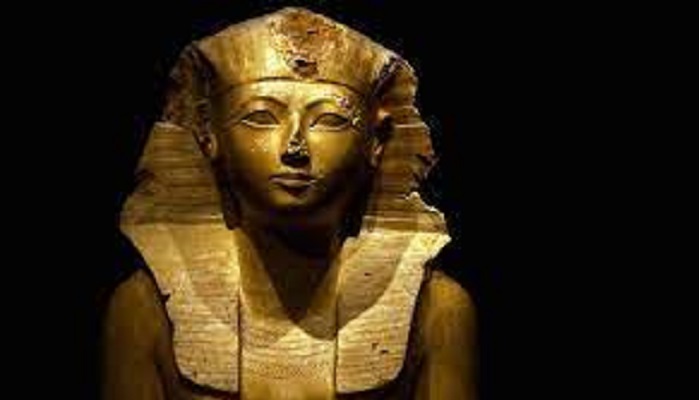Regarded as the third woman to become pharaoh in the history of ancient Egypt 3000 years, Hatshepsut was an iconic woman whose reign is associated with great architectural wonders and the prosperity of Egypt.
Historical accounts of her as a female pharaoh are quite a few because she insisted on being depicted as a man with a beard and muscles. Also after her death, almost every statue, inscription, and information about her were eradicated.
Hatshepsut Rose to Power after her Marriage to her Half Brother
Hatshepsut was born to King Thutmose I, however, this was not how she rose to the position of being pharaoh in Egypt. Her rise to power came after she was made to marry her half-brother at the age of 12.
Hatshepsut was the elder of 2 daughters born to her father. Her half-brother was born from her father’s relationship with one of his secondary wives. He took over of the throne when Hatshepsut’s father died in 1492 B. C.
Thutmose II, Hatshepsut’s half-brother turned husband also passed away at a young age in 1479 B. C. They both had a daughter named Neferure while Thutmose II also had an infant son from another woman named Thutmose III.
Because of how young Thutmose III was, he couldn’t take charge of Egypt and Hatshepsut had to step in and act as regent.
After about 7 years of being the regent to her growing stepson, the third Egyptian Pharaoh decided to take full control of powers, becoming a pharaoh and co-ruler of Egypt.
There are different given reasons as to why she took this decision – one states that she got power addicted and so decided to take control of the powers and rulership of the country. However, scholars have disputed this stating that there was brewing chaos within the royal family for the throne and so she had to step in in order to safeguard the position for her stepson.
SEE ALSO: 10 Greatest African Queens They Didn’t Tell You About
Hatshepsut’s Rise, Though Controversial, Brought Successes to Egypt

The new Pharaoh fought greatly to keep herself on the throne and prove that she was worthy of the position. Insisting that she has a direct lineage to the throne, she also had to remind people who fought against her that her father made her successor.
She said she wanted to be portrayed as a man with muscles and beards and so her statues and images were masculine looking. Sometimes she wore male clothes but she was mostly in traditional female regalia.
As part of her government, she kept her supporters in key positions including Senenmut who was her chief minister and suspected to have been her lover.
Her reign saw the rise of beautiful architecture, especially in the area around Thebes. One of such building project was the enormous memorial temple at Deir el-Bahri which is still referred to as her greatest achievement as pharaoh.
Also, the dynasty before her brought about the great destruction of arts and monuments. The queen took it upon herself to rebuild these structures and even made them more beautiful and greater.
She is credited for the rebuilding of the Precinct of Mut located at Karnak, the construction of the Red Chapel at the same location, and also the construction of the Temple of Pakhet at Beni Hasan.
Most of the monuments featured in many museums around the world were built by this pharaoh. The tallest standing obelisks in the world were commissioned during her reign as the pharaoh of Egypt.
Another great achievement Hatshepsut had during her reign was the authorization of a trading expedition. With this, she was able to restore wealth to the land of Egypt by returning ivory, ebony, gold, leopard skins, and frankincense from the Land of Punt which is now known as Eritrea.
These returns were of great use to the land of Egypt and this greatest female pharaoh was the first to transplant trees from country to country, burn incense and use them as eyeliner and also introduce foreign animals such as apes, giraffes, and panthers to Egypt.
Egypt knew no other female ruler who achieved as incredibly as Pharaoh Hatshepsut did until her death around 1458.
Something she did that rarely gets enough publication is her military campaign. She single-handedly led a successful military campaign against the kingdom of Kush.
READ ALSO: Queen Amanirenas- 10 Fascinating Details About One Of Africa’s Greatest Queens
Pharaoh Hatshepsut Died sometime in her 50s and her Reign was Almost Erased from History
When this female pharaoh was age 50, she passed away and was buried in the Valley of the Kings located behind Deir el-Bahri. She was buried alongside her father’s sarcophagus because she requested to be laid beside him in the tomb. It was also a way for her to legitimize her rulership as monarch of Egypt.
When her stepson, Thutmose III took over power, he slowly erased all evidence of her from history. These pieces of evidence were in form of monuments and images of her as king which were on the temple Hatshepsut.
The reason behind this act has been debated over the years as some do not believe it was a malicious act seeing that he was part of the queen’s government and close to her. The argument in his favor was that he probably wanted to ‘close the gap in the line of the dynasty’s male succession’. Due to this act, a lot about the female pharaoh was unknown to the world.
It wasn’t until sometime in 1922 that scholars began to dig deep after the findings of hieroglyphics on the walls of the temple built by Hatshepsut. Discoveries of one of her sarcophagus were found empty sometime in the early 1900s.
It wasn’t until the early 2000s (2007) that archaeologists discovered her mummy and matched it to a piece of missing molar tooth found in a wooden box bearing the pharaoh’s name, that her existence was confirmed.
Possible Cause of Pharaoh Hatshepsut’s Death
According to thecollector.com, the female Pharaoh may have accidentally caused her own death. The site said that after an examination of the mummy identified to belong to the pharaoh, it was realized that she suffered from arthritis, diabetes, and bone cancer.
It was found that Hatshepsut may have possibly died from cancer-related complications. She initially had a genetic skin disease which she tried to cover up with lotions unbeknownst to her that the lotions she applied were cancerous. Cancer seeped into her skin leading to cancer of the bone. This is why it is claimed that she accidentally caused her own death.
Hatshepsut’s mummy was also described as overweight and a little over 5 feet in height. She had long, golden hair and red-painted fingernails.
A Theory Suggests the Greatest Female Egyptian Pharaoh Might be Queen Sheba the Bible
There is a theory that suggests that Pharaoh Hatshepsut is the biblical Queen Sheba and the theorist backed up his allegations with proof.
In Immanuel Velikovsky’s ‘Ages of Chaos’, he argued that Hatshepsut’s dynasty was incorrectly dated and that it was actually 5 centuries later than the 18th century stipulated.
With this, the greatest female pharaoh and the Biblical King Solomon would be contemporaries.
There are accounts of the Queen of Sheba that describe her as ‘the woman who, at that time, ruled as queen of Egypt’. The author of Ages of Chaos also stated his beliefs about the land of punt and Jerusalem being the same.
The treasures and wealth brought back to Egypt from the Land of Punt were said to have been found by the Jordan River Valley.
This theory has remained a topic of debate for a while and more of it can be found in the book released in 1895.




















